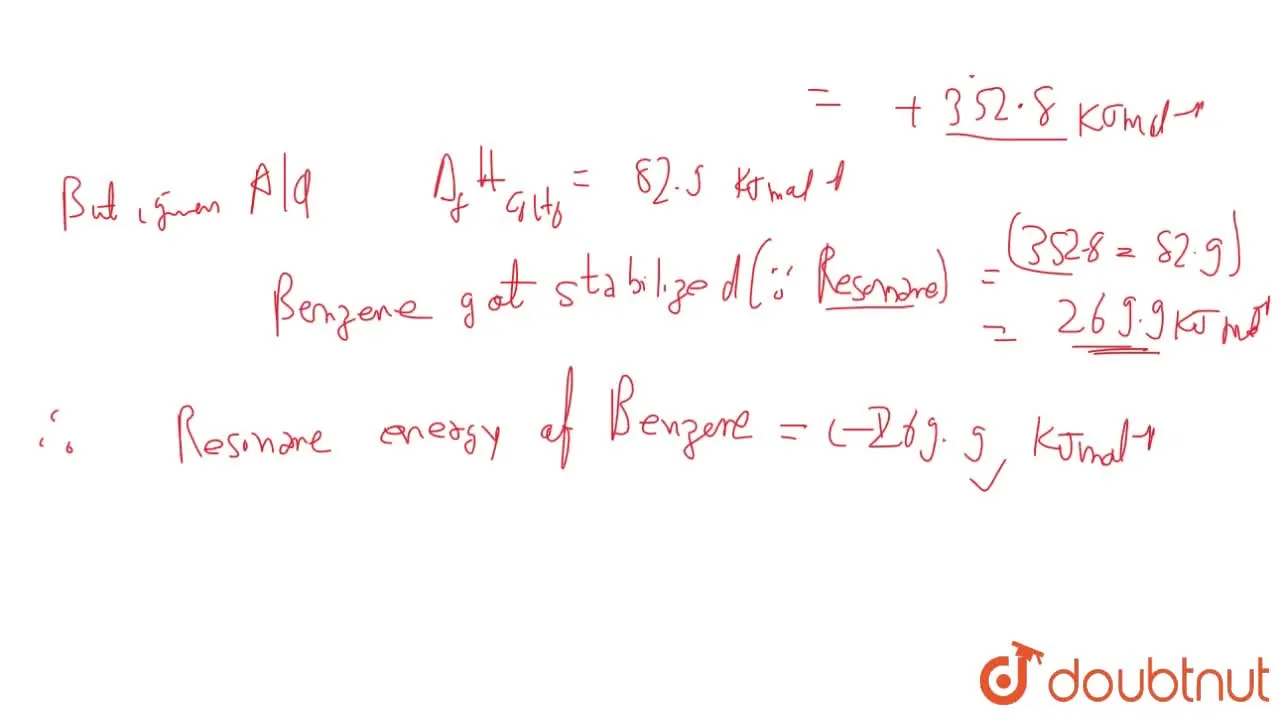Calculate the resonance energy of gaseous benzene form the following data.
BE(C−H)=416.3kJmol−1
BE(C−C)=331.4kJmol−1
BE(C=C)=591.1kJmol−1
ΔsubHΘ(C,graphite)=718.4kJmol−1
ΔdissHΘ(H2,g)=435.9kJmol−1
ΔfHΘ(benzene,g)=82.9kJmol−1
To compute resonance enegry, we compare the calaculated value of ΔfHΘ (benzene, g) with the given one. To calculate ΔfHΘ (benzene, g) we add the following reactions.
(a). 6C(g)+6H(g)→C6H6(g),ΔHΘ=−(3BEC−C+3BEC=C+6BEC−H)
(b) 6C(graphite)→6C(g)ΔHΘ=6×718.4kJmol−1
(c) 3H2(g)→6H(g)ΔHΘ=3×435.9kJmol−1
¯¯¯¯¯¯¯¯¯¯¯¯¯¯¯¯¯¯¯¯¯¯¯¯¯¯¯¯¯¯¯¯¯¯¯¯¯¯¯¯¯¯¯¯¯¯¯¯¯¯¯¯¯¯¯¯¯¯6C(graphite)+3H2(g)→C6H6(g)––––––––––––––––––––––––––––––––––––––
The corresponding enthalpy change is
ΔfHΘ=−(3BEC−C+3BEC=C+6BEC−H)+[6×718.4+3×435.9]kJmol−1
=[−(3×331.4×591.1+6×718.4+3×435.9]kJmol−1
The given ΔfHΘ is ΔfHΘ (benzene, g) =82.9kJmol−1
This means benzene become more stable by (352.8−82.9)kJmol−1, i.e., 269.7kJmol−1
This is its resonance enegry.
Related Playlists
Similar Questions
Given ΔiHΘ(HCN)=45.2kJmol−1 and ΔiHΘ(CH3COOH)=2.1kJmol−1. Which one of the following facts is true?
View SolutionCalculate the resonance enegry of toulene (use Kekule structure form the following data
C7H8(l)+9O2(g)→7CO2(g)+4H2O(l)+ΔH,ΔHΘ=−3910kJmol−1
C7H8(l)→C7H8(g),ΔHΘ=38.1kJmol−1
ΔfHΘ(water)=−285.8kJmol−1
ΔfHΘ[CO2(g)]=−393.5kJmol−1
Heat of atomisaiton of H2(g)=436.0kJmol−1
Heat of sulimation of C(g)=715.0kJmol−1
Bond energies of C−H,C−C, and C=C are 413.0,345.6, and 610.0kJmol−1.View SolutionCalculate the lattice energy of the reaction
Li⊕(g)+CIΘ(g)→LiCI(s)
from the following data:
ΔsubHΘ(Li)=160.67kJmol−1,12D(CI2)=122.17kJmol−1IP(Li)=520.07kJmol−1,EA(CI)=−365.26kJmol−1 and ΔfHΘ(LiCI)=−401.66kJmol−1View SolutionCalculate the enthalpy of combustion of benzene (l) on the basis of the following data:
a. Resonance energy of benzene (l)=−152kJ/mol
b. Enthalpy of hydrogenation of cyclohexene (l)=−119kJ/mol
c. ΔfHΘC6H12(l)=−156kJmol−1
d. ΔfHΘofH2O(l)=−285.8kJmol−1
e. ΔfHΘofCO2(g)=−393.5kJmol−1View SolutionCalculate the EA of O atom to O2− ion from the following data:
i. ΔfHɵ[MgO(s)]=−600kJmol−1
ii. ΔuHɵ[MgO(s)]=−3860kJmol−1
iii. IE1+IE2 of Mg(g)=2170kJmol−1
iv. ΔdissHɵ of Mg(s)=+494kJmol−1
v. ΔsubHɵ of Mg(s)=+150kJmol−1View SolutionFind ΔH of the process
NaOH(s)→NaOH(g)
Given: ΔdissHΘofO2=151kJmol−1
ΔdissHΘofH2=435kJmol−1
ΔdissHΘofO−H=465kJmol−1
ΔdissHΘofNa−O=255kJmol−1
ΔsolnHΘofNaOH=−46kJmol−1
ΔfHΘofNaOH(s)=−427kJmol−1
ΔsubHΘofNa(s)=109kJmol−1View SolutionUsing the bond enthalpy data given below, calculate the enthalpy of formation of acetone (g).
Bond enegry C−H=413.4kJmol−1,
Bond enegry C−C=347.0kJmol−1,
Bond enegry C=O=728.0kJmol−1,
Bond enegry O=O=495.0kJmol−1,
Bond enegry H−H=435.8kJmol−1,
ΔsubHΘC(s)=718.4kJmol−1View SolutionCalculate enthalpy change for the process CCl4(g)→C(g)+4Cl(g) and calculate Bond enthalpy of C−Cl bond in CCl4
Given: ΔvapHθ=30.5kJmol−1,ΔfHθ(CCl4)=−135.5kJmol−1,ΔaHθ(C)=715kJmol−1andΔaHθ(Cl2)=242kJmol−1View SolutionCalculate the standard Gibbs free energy change from the free energies of formation data for the following reaction:
C6H6(l)+152O2(g)→6CO2(g)+3H2O(g)
Given that ΔfGΘ=[C6H6(l)]=172.8kJmol−1
ΔfGΘ[CO2(g)]=−394.4kJmol−1
ΔfGΘ[H2O(g)]=−228.6kJmol−1View SolutionCalculate the enthalpy of combustion of benzene (l) on the basis of the following data:
a. Resonance energy of benzene (l)=−152kJ/mol
b. Enthalpy of hydrogenation of cyclohexene (l)=−119kJ/mol
c. ΔfHΘC6H12(l)=−156kJmol−1
d. ΔfHΘofH2O(l)=−285.8kJmol−1
e. ΔfHΘofCO2(g)=−393.5kJmol−1View Solution


